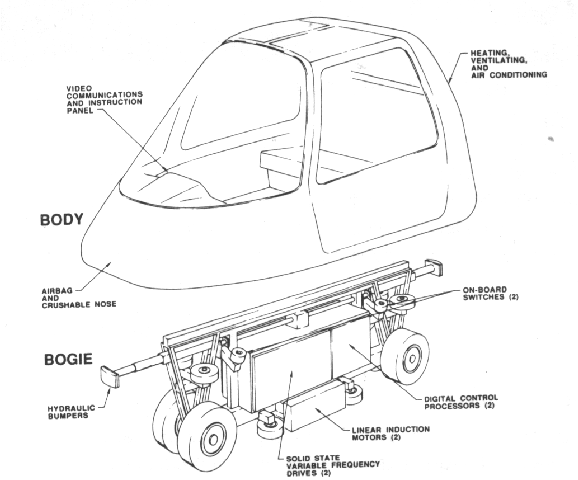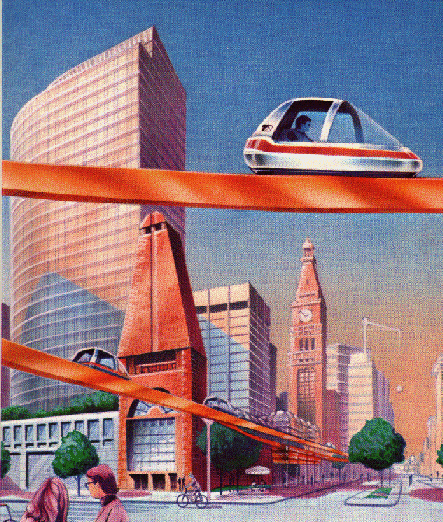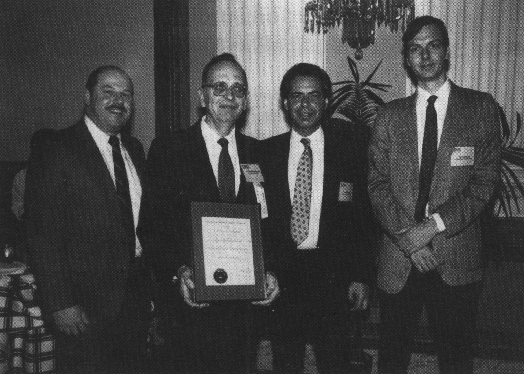

The Illinois Regional Transportation Authority (RTA) chose a team of contractors June 3 to develop an automated personal rapid transit system based on technology invented at and owned by the University of Minnesota. The RTA voted to award an $18 million contract to a team comprised of the Taxi 2000 Corporation and Raytheon Company, which will invest an additional $20 million to build a half-mile prototype system to test the safety and reliability of the technology. Based on those results, the RTA will vote on whether to build a three-mile track in the Chicago suburb of Rosemont.
Raytheon's backing and the RTA's decision vindicate 25 years of research, teaching and public education by a former University of Minnesota professor of mechanical engineering, J. Edward Anderson. He co-founded Automated Transportation Systems, Inc., the predecessor of Taxi 2000 Corp., in 1984 with four other individuals and with help from the University's Office of Patents and Licensing. The University granted Anderson's company an exclusive worldwide license to commercialize the personal rapid transit (PRT) technology, which is protected by U.S. and foreign patents financed by and issued to the University. The University received equity in Taxi 2000 Corp. and a royalty for each vehicle and mile of guideway built by the company or sub-licensees.
Anderson's PRT system, originally called Alpha but now called Taxi 2000, has small, computer controlled vehicles traveling on a network of lightweight, elevated guideways. Carrying from one to four passengers, the electric vehicles enter and exit the main guideway via ramps to off-line stations. This design enables passengers to purchase a ticket for any station in the network and then travel to that station without stopping. The vehicles' small size lets passengers travel in privacy or in small groups, while making the system efficient to run and less costly to build than transit systems based on large train-like vehicles.
What most confuses people about the Taxi 2000 system is the vehicles' small size. Anderson explains that vehicle and passenger weight must be kept low in order for the guideway and support posts to be less imposing and less costly, and for the system to use energy most efficiently. Conventional thinking is that to have enough capacity to make a system worthwhile, each vehicle must accomodate at least 15 passengers. "That's intuitive, and what I've found in this kind of design is that raw intuition is worthless; you really have to go through careful analysis of the optimal features for the system," Anderson says.
Anderson calls automated systems with larger vehicles group rapid transit, not PRT. He has been proven right about their lack of efficieny: they must travel slowly because passengers are standing, and they usually travel mostly empty. Unfortunately, the high cost and low efficiency of the two existing group rapid transit systems, one at the University of West Virginia in Morgantown (20 passengers per vehicle), and one at Duke University Hospital in Durham, North Carolina (22 passengers per vehicle), has been used by critics to argue against investments in PRT.
Years of analysis have brought Anderson to these arguments explaining how the Taxi 2000 system meets fundamental urban transit needs:

The Taxi 2000 guideway is about 42 inches wide by 42 inches deep, and is held about 16 feet in the air by two-foot diameter steel posts spaced every 60 feet, or hung by brackets from buildings. To keep out snow and ice, the guideway will be covered by a thin sheet of steel or plastic, with a slot in the center where the vehicle connects to the bogey. Stations would have from one to twelve vehicle berths, with stairs and an elevator to take riders to the second-story automatic ticketing machine and the vehicles. Such a station would be 16 feet wide and 33 feet long, and would have a capacity of about 650 vehicles per hour. Larger stations with capacities 2,000 vehicles per hour would be placed in downtown areas, airports, and shopping and entertainment centers. By providing easy access 24 hours a day to any site within a downtown or other densely built area, the Taxi 2000 system could drastically reduce the need for parking ramps and streets in these areas.
"Ed Anderson deserves a great deal of credit for carrying this technology forward. He has survived much skepticism and many highs and lows when we thought we had a deal with a company or developer," says Tony Potami, the University's associate vice president for research and technology transfer. Potami served on the Taxi 2000 Corp. board of directors until 1989, when he was replaced by Tony Strauss, assistant director of the University's Office of Patents and Licensing. Both men have assisted Anderson in discussing license terms with corporations and construction contracts with public and private developers. Most groups were deterred by the need to spend about $30 million to build a prototype and test the technology thoroughly before a public system could be built.
We would have preferred to have a Minnesota company build the prototype and demonstration system here in the Twin Cities, perhaps connecting the University's St. Paul and Minneapolis campus or at a high-visibility site such as the airport-494-Mall of America area in Bloomington," Strauss says. "But we did all we could to make that happen and it didn't work out, so we're pleased for Ed and everyone else involved that Raytheon and the Illinois RTA are going ahead. We'll continue to work with Ed and Raytheon to provide information to Twin Cities developers and the public about potential uses of the technology here."

In 1989 J. Edward Anderson (second from left) was honored as an outstanding American inventor of the year by the Intellectual Property Owners Foundation. With Anderson at the award ceremony were, from left, John Thuente, former director, Office of Patents and Licensing; Tony Potami, associate vice president for research and technology transfer; and Tony Strauss, assistant director, patents and licensing.
For more info e-mail daeron@geom.umn.edu